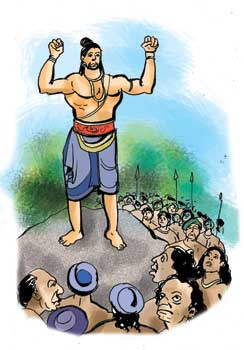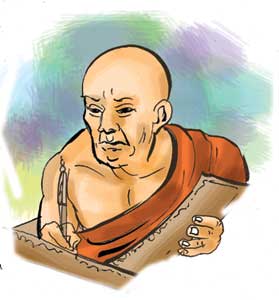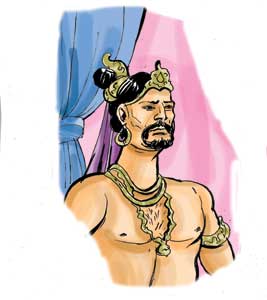
King Vijayabahu 3~This article is part of a continuing series on the ‘Mahavamsa,’ the recorded chronicle of Sri Lankan history~
2. This is a dynasty that came to Sri Lanka on the day the Sri Maha Bodhi was brought. They are supposed to be one of the groups, that accompanied the Sri Maha Bodhi. Yet, the heredity of this king remains debatable. No common decision is arrived at so far. Scholars put forward various theories. Some say that Vijayamalla belonged to the Kalinga dynasty. That may be because, as in Nissankamalla and Sahassamalla, he too has 'Malla,' at the end of his name. 3. The author of 'Kausilumina' points out that this dynasty was connected to the Pandyan line. According to the Dondra inscription, he is a descendent of Nembara Somaraja. According to literary evidence a place named Nembara is connected to them. This is spoken of as a small village, close to Dambadeniya. All this evidence from different sources is sought to give the king a royal heredity. So these bits of information may not be actual facts.
5. That is according to literary evidence. However, they would have been rulers of some remote area. Most of King Vijayabahu's early life, had been spent either in jungle areas or army camps. However, he had been able to bring other leaders, under his control. Those who refused his leadership, were made to surrender forcibly. 6. He was able to assemble a large number of warriors. This king succeeded in defeating the Tamil leaders, who were powerful in Maya-rata. This proves the fact that there were colonies of Tamil people in Maya-rata. Though this part of the country did not directly feel the impact of Magha's rule, these areas too would have had at least a little influence. However, with the passage of time, Tamils in the Raja-rata had begun to support Magha. Gradually, the Tamils who were residing in Maya-rata also began to migrate to Polonnaruwa and support Magha.
8. The distance from Dambadeniya to Polonnaruwa is about 75 miles. To Kurunegala it is about 18 miles. Though Dambadeniya was a naturally protected area, this king tried to erect walls and make it a quite fortified city. |
|
||||||
|| Front
Page | News | Editorial | Columns | Sports | Plus | Financial
Times | International | Mirror | TV
Times | Funday
Times || |
| |
Reproduction of articles permitted when used without any alterations to contents and a link to the source page.
|
© Copyright
2008 | Wijeya
Newspapers Ltd.Colombo. Sri Lanka. All Rights Reserved. |
 1. King Vijayabahu III did not have a direct relationship to the previous kings. His father was Vijayamalla. Those who were engaged in literary work during this period, give a royal connection to him. They have described in detail, these connections. However it is said that Vijayamalla was the ruler of a small province. This too is debatable. Historians who write about King Vijayabahu III have depicted him as one coming down from King Sirisangabo's generation.
1. King Vijayabahu III did not have a direct relationship to the previous kings. His father was Vijayamalla. Those who were engaged in literary work during this period, give a royal connection to him. They have described in detail, these connections. However it is said that Vijayamalla was the ruler of a small province. This too is debatable. Historians who write about King Vijayabahu III have depicted him as one coming down from King Sirisangabo's generation. 4. Anyway, all this cannot be the work of the eulogists. These theories are a result of the marriage alliances of King Vijayabahu's forefathers. The recorded history of this period, make little mention of the life of King Vijayabahu. Accordingly, when he was young, he had been a Vanniyar. Vanniyars are a section of leaders who lived during the 13th century AD. They were feudal chieftains.
4. Anyway, all this cannot be the work of the eulogists. These theories are a result of the marriage alliances of King Vijayabahu's forefathers. The recorded history of this period, make little mention of the life of King Vijayabahu. Accordingly, when he was young, he had been a Vanniyar. Vanniyars are a section of leaders who lived during the 13th century AD. They were feudal chieftains. 7. As time went by, Vijayabahu III, automatically became the leader of the Sinhala people. Once, he succeeded in chasing Magha's army back to Polonnaruwa when they tried to advance towards Dambadeniya. King Vijayabahu III was able to consolidate his power in Maya-rata. Then Dambadeniya was also a part of Maya-rata. Dambadeniya was situated in a slightly higher elevation and takes the shape of a little rock. It is a place of scenic beauty.
7. As time went by, Vijayabahu III, automatically became the leader of the Sinhala people. Once, he succeeded in chasing Magha's army back to Polonnaruwa when they tried to advance towards Dambadeniya. King Vijayabahu III was able to consolidate his power in Maya-rata. Then Dambadeniya was also a part of Maya-rata. Dambadeniya was situated in a slightly higher elevation and takes the shape of a little rock. It is a place of scenic beauty.